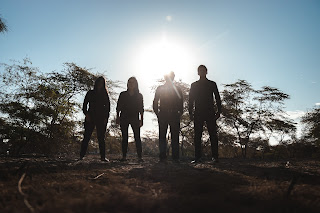Lacrimosa or that rare mixture called cultural identity
Two girls and two boys who don’t look like anything found a space in the music to sound like one.
By Nelson
Peñaherrera Castillo.
Photographs & videos provided by Telón de
Boca.
PIURA CITY, Peru – We live almost unconsciousness into a polyphonic world. If we fit to the etimology –multiple sounds—it’s enough to get out to the street, and if we focus in what we hear, we’ll notice not all has similar tone and intensity. The problem is those sounds are not combined, they don’t have the purpose to set up like a pretty sequence to the ear. That’s why we end to experience noise, probably a stress episode that will bring us to get inside our home looking for urgent relaxation.
The polyphony in the music is all the
opposite, for sure, Inside the same melody we go listening to, the sounds don’t
own an equal tone but all set up as good as the ear feels caressed as well as
it’s able to raise the alert levels of the brain not in distress but working
the same, or better, than a coffee at seven in
the morning.
Beyond the polyphony, the
neuroscience proposes that listening to the music stimulates the area of our
brain in charge of the control and the movement. And it’s the probable reason
why the human race was
developing it as a conscious activity until turning it an art, the related
specialists say, can bring us to develop positive sentiments of solidarity and
cooperation. It also stimulates or enhances the language, if not,
how do we make the babies go articulating in a progressive way?
The not-too-opposite match
Adriana Sánchez Miranda, 29,
knows it very well. She’s the mother of a 2-year-old baby girl, she has studied
Cultural management at University of Piura (Udep, as in Spanish), she believes in the formative, magic power
of the music. With other friend, Paula Corrales, 22, and two more friends,
Jesús Casariego Mejía, 19, and Manuel Rosas Rubio, 24, have met to share and
show that sentiment but like polyphonic music.
They named Lacrimosa in
memory of Wolfgang Amadeus Mozart’s Requiem (1756-1791), considered as
one of the great genius of the world’s music. And like not all the voices at
the street are not equal but they can set up in something harmonic, Lacrimosa
members are dedicated to activities or their knowledge look like different.
Manuel is an architect,
although he works completely in the music now and he enjoys much time by
keeping his plants (“I’ve got
precious sunflowers, sweet potatoes, tomatoes, ficus, epazotes, and aloe veras”).
Jesús studies Laws, he does capoeira. Paula wants to specialize in
Sound Direction for TV & films.
They are four because the basic
sounds forming a polyphony are four. Adriana is the alto, Jesús is the
baritone, Paula is the soprano, and Manuel is the tenor. The four met in Udep Choir, and they set up voices,
activities, lifestyles, preferences as well as they combine the campus and the
city around.
The differences enrich Piura
Their genre is the classic
music, but they also include music of Piura in the repertoire in their same
vocal style. “The polyphonic music is a team work,” they affirm. Paula thinks
it has the ability to relax the human being. “I
feel it made my ear more acute,” Adriana
comments. “when I listened to Listz’s ave Maria, I felt I was flying,”
Jesús adds.
Just to prove that the
differences complement, even in personal music preferences, nobody has to do
with nobody. Adriana is creole by family heritage, her parents danced to marinera
and tondero, she and her sister formed a club to promote Peruvian creole
music. Paula feels free with the k-pop. Jesús performs rap. Manuel is mostly
pop as he has his own band, Manlolo,
although he began listening to José José, and he made the impossible to join a
mariachi group until he got it.
Manuel himself considers that
Piura is a city with culture over other ones he know across Peru… unlike many
could think. “When you take a taxi, the driver uses to be a guy who has many
conversation topics and he is very well informed about his reality
The other three coincide there
is an interesting cultural wave in Piura Department that is worthy to follow
exploring, knowing, and promoting, that even it’s taking the streets, like the
wall paintings at Sánchez Cerro Avenue, just one of the sides of Piura Downtown. And
everything seems to be amalgamated in harmony although it doesn’t seem so.
Lacrimosa launches with presentations in Piura city that,
according Juanma Garcias with Telón de
Boca, the cultural promotor
managing them, it could expand to some cities across Piura Department. Who wants to enjoy their art, please contact +51974048610.
© 2022 Asociación Civil Factor
Tierra. All Rights Reserved. Comment this in the box below or our Facebook and Twitter accounts. Would you like to know the places quoted in
this entry? Write us at factortierra@gmail.com for more information.






Comentarios
Publicar un comentario